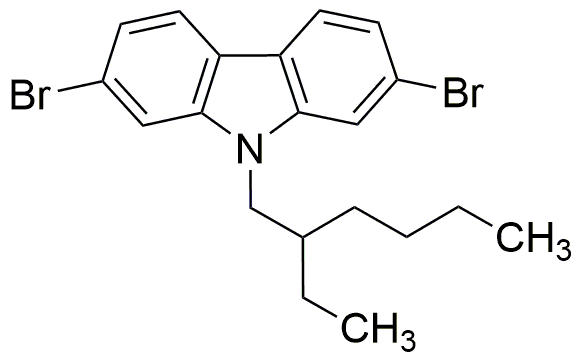2,7-Dibromo-9-(2-ethylhexyl)carbazole is widely utilized in research focused on:
- Organic Photovoltaics: This compound is used as a material in organic solar cells, enhancing their efficiency and stability. Its unique structure allows for better light absorption and charge transport.
- Light-Emitting Diodes (LEDs): It serves as a key component in the development of high-performance LEDs, contributing to improved brightness and energy efficiency in various lighting applications.
- Fluorescent Sensors: The compound is employed in creating fluorescent sensors for detecting environmental pollutants, providing a sensitive and reliable method for monitoring air and water quality.
- Polymer Additives: Used as an additive in polymer formulations, it enhances thermal stability and mechanical properties, making it valuable in the production of durable materials for automotive and construction industries.
- Research in Photonic Devices: It is explored in the development of advanced photonic devices, offering potential applications in telecommunications and data processing due to its favorable optical properties.
Información general
Propiedades
Seguridad y normativas
Aplicaciones
2,7-Dibromo-9-(2-ethylhexyl)carbazole is widely utilized in research focused on:
- Organic Photovoltaics: This compound is used as a material in organic solar cells, enhancing their efficiency and stability. Its unique structure allows for better light absorption and charge transport.
- Light-Emitting Diodes (LEDs): It serves as a key component in the development of high-performance LEDs, contributing to improved brightness and energy efficiency in various lighting applications.
- Fluorescent Sensors: The compound is employed in creating fluorescent sensors for detecting environmental pollutants, providing a sensitive and reliable method for monitoring air and water quality.
- Polymer Additives: Used as an additive in polymer formulations, it enhances thermal stability and mechanical properties, making it valuable in the production of durable materials for automotive and construction industries.
- Research in Photonic Devices: It is explored in the development of advanced photonic devices, offering potential applications in telecommunications and data processing due to its favorable optical properties.
Documentos
Hojas de datos de seguridad (HDS)
La SDS proporciona información de seguridad completa sobre la manipulación, el almacenamiento y la eliminación del producto.
Especificación del producto (PS)
La PS proporciona un desglose completo de las propiedades del producto, incluida la composición química, el estado físico, la pureza y los requisitos de almacenamiento. También detalla los rangos de calidad aceptables y las aplicaciones previstas del producto.
Certificados de análisis (COA)
Busque certificados de análisis (COA) ingresando el número de lote del producto. Los números de lote y de partida se pueden encontrar en la etiqueta de un producto después de las palabras "Lote" o "Lote".
Número de catálogo
Número de lote/lote
Certificados de origen (COO)
Este certificado de origen confirma el país en el que se fabricó el producto y también detalla los materiales y componentes utilizados en él y si se deriva de fuentes naturales, sintéticas u otras fuentes específicas. Este certificado puede ser necesario para cumplir con las normativas aduaneras, comerciales y regulatorias.
Número de catálogo
Número de lote/lote
Hojas de datos de seguridad (HDS)
La SDS proporciona información de seguridad completa sobre la manipulación, el almacenamiento y la eliminación del producto.
DownloadEspecificación del producto (PS)
La PS proporciona un desglose completo de las propiedades del producto, incluida la composición química, el estado físico, la pureza y los requisitos de almacenamiento. También detalla los rangos de calidad aceptables y las aplicaciones previstas del producto.
DownloadCertificados de análisis (COA)
Busque certificados de análisis (COA) ingresando el número de lote del producto. Los números de lote y de partida se pueden encontrar en la etiqueta de un producto después de las palabras "Lote" o "Lote".
Número de catálogo
Número de lote/lote
Certificados de origen (COO)
Este certificado de origen confirma el país en el que se fabricó el producto y también detalla los materiales y componentes utilizados en él y si se deriva de fuentes naturales, sintéticas u otras fuentes específicas. Este certificado puede ser necesario para cumplir con las normativas aduaneras, comerciales y regulatorias.


